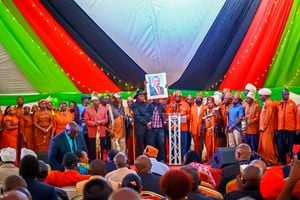Pathologists: Pakistani Journalist Arshad's life could have been saved

Arshad Sharif with his wife Javeria Siddique. Ms Siddique, the widow of the prominent Pakistani journalist, who was killed a year ago, filed a law suit on Wednesday against Kenyan police she accuses of killing her husband.
What you need to know:
- His widow Javeria Siddique has file a case against the General Service Unit over the shooting.
Mr Arshad Sharif, a Pakistani journalist who was killed in Kenya a year ago in an incident that attracted the attention of President William Ruto, could have survived if he had been rushed to hospital immediately after being shot, pathologists have said.
A statement released by Kenya's National Police Service (NPS) said Mr Sharif was shot dead along Magadi Road in Kajiado County when a vehicle he was travelling in failed to stop after being ordered to do so by officers attached to the General Service Unit (GSU).
Two pathologists, Dr Edwin Walong and Prof Emily Rogena, said an examination of his body and the report prepared by government pathologist Johansen Oduor showed that the deceased was shot at close range.
The Nation showed the two pathologists the pictures taken before the autopsy and they shared their observations on the journalist's death.
Dr Walong, said a close look at the body tissues of the deceased showed that the lungs were hit but the amount of bleeding showed that he could have survived.
"Looking at these tissues, it appears that the lung was hit but the level of haemorrhage shows that he could have survived if he was attended to in the golden hours of up to two hours," the doctor told the Nation.
He also said it was highly unlikely that the bullet that hit Mr Sharif would have passed through many other intervening objects.
This was echoed by Prof Rogena, who said that the deceased was shot at close range and a look at the exit wound on his body clearly showed that the bullet did not pass through many intervening objects.
"From the way the exit wound looks, it is clear that the deceased was not that far from the shot and the bullet did not pass through a number of objects before hitting him," Prof Rogena told the Nation at her Upper Hill office.
Asked if there were any signs of torture on his body, Prof Rogena denied this, saying that if the family had found a section of his nails cut off, it would have been done by the pathologist for the purpose of DNA testing.
The pathologist's revelations have brought to light a stalled investigation in which sleuths attached to the National Police Service (NPS) were investigating whether the deceased was killed with another firearm and not when police officers attached to the Directorate of Criminal Investigations (DCI) fired at the vehicle in which he was travelling.
Mr Sharif, who had fled his home in fear of his life, was last seen alive at Ammodump Kwenia, a shooting range and pub where he had attended a party with US soldiers. Ammodump Kwenia is owned by Mr Waqar Ahmed.
On the fateful day, he left with Mr Khuram Ahmed, a brother of the range's owner, and they were on their way to an apartment on Riverside Drive when he died.
A worker, who spoke to the Nation in confidence as he is not authorised to speak to the media, and who was there the day the duo left, said they were all fine when they left for the city.
"They were here and even left with Khuram after attending a party that was held inside the shop," the worker said.
It is worth noting that two investigations have been launched into the journalists' deaths, neither of which has yet announced its findings.
The first investigation was carried out by detectives from the Directorate of Criminal Investigations (DCI), but was halted to allow time for the Independent Policing and Oversight Authority (IPOA) to complete its investigation.
While Mr Sharif was enjoying the party with friends, a man identified as Mr Douglas Wainaina Kamau reported to Pangani Police Station that his vehicle had been stolen in the Ngara area.
According to Mr Wainaina, his vehicle, registration number KDJ 700F, was a Mercedes Benz, while the one in which Mr Sharif was being driven was a Toyota Landcruiser, registration number KDG200M.
Mr Wainaina, a businessman involved in horticulture, reported that the vehicle had disappeared while his son was inside. The matter was recorded under Occurrence Book (OB) number 70/23/10/2022.
Two hours later, the vehicle was located in the Ole Tepes area of Kajiado County and GSU officers were asked to keep an eye on the vehicle and stop it if it was reported missing.
Immediately after the shooting by the GSU officers, Mt Khurram contacted his brother Waqar, who was still at the shop, and told him that Mr Sharif had been shot and was bleeding profusely. Mr Waqar then joined them before the body of the deceased was taken to Chiromo mortuary in Nairobi County.
The Nation has established that Mr Wainaina had a tough time trying to get his vehicle back from the police.
He said he even had a meeting with President Ruto who wanted to know what really happened on the fateful day that led to the Pakistani journalist's death. He also met with Inspector General of Police Japheth Koome.
"I had a series of meetings with Mr Koome and even President Ruto who wanted to understand what really happened. Honestly, I never knew that the report I made at Pangani Police Station could end up bringing all the problems I experienced," Mr Wainaina told the Nation.
He said the police took a long time with his car and were unwilling to return it to him even after he withdrew the case against his son.
The police had charged his son with stealing his father's car, but Mr Wainaina decided to forgive him. This did not go down well with the police, who arrested and charged him again on several occasions, but he maintained that he had forgiven him.
Today, Ms Javeria Siddique, Mr Sharif's widow, will file a case against the General Service Unit (GSU), which she accuses of being responsible for her husband's death.
Through her lawyer, Dudley Ochiel, Mrs Siddique will file the suit in the Kajiado High Court.
The petition, which outlines the basis of the case, claims that there have been no substantive investigations into the incident, or if there have been, they have not been prompt, independent, impartial, effective, accountable or resulted in the prosecution of those behind the violation.
In her application, Ms Siddique demands that Kenya's Attorney General, the National Police Service and the Director of Public Prosecutions take action to 'punish and prosecute the police officers who killed Arshad Sharif'.
The court is also asked to order the Attorney General to issue a public apology within seven days of the court's order.
The apology should include an acknowledgement of the facts and an acceptance of responsibility by the Kenyan government to the family of Arshad Sharif.
Speaking to the Nation from Pakistan, where she is currently based, Mrs Siddique expressed her determination to seek justice for her husband and hold those responsible for his death to account.
"My husband was killed in cold blood and the perpetrators are still at large, causing us immense pain. Something needs to be done," said Ms Siddique, stressing that the Kenyan government should have apologised by now.




